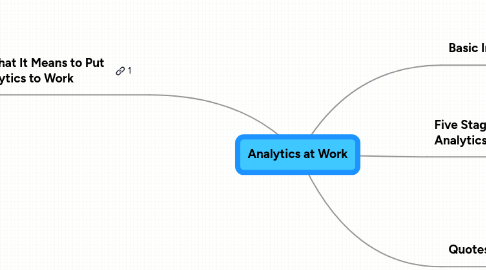
1. 1) What It Means to Put Analytics to Work
1.1. Benefits of being analytical
1.1.1. Help manage and steer the business in turbulent time
1.1.2. Know what's really working
1.1.3. Leverage previous investments in IT and information
1.1.3.1. more insight
1.1.3.2. faster execution
1.1.3.3. more business value in many processes
1.1.4. Cut costs / improve efficiency
1.1.5. Manage risk
1.1.6. Anticipate changes in market conditions
1.1.7. Have a basis for improving decisions over time
1.2. analytical
1.2.1. use of analysis, data, and systematic reasoning to make decisions
1.3. key questions
1.3.1. dimensions
1.3.1.1. Time frame
1.3.1.1.1. past
1.3.1.1.2. present
1.3.1.1.3. future
1.3.1.2. Innovation
1.3.1.2.1. information
1.3.1.2.2. insight
1.3.2. questions (Fig1-1, p7)
1.3.2.1. What happened?
1.3.2.1.1. past
1.3.2.1.2. information
1.3.2.1.3. Reporting
1.3.2.2. How and why did it happen?
1.3.2.2.1. past
1.3.2.2.2. insight
1.3.2.2.3. Modeling, experimental design
1.3.2.3. What is happening now?
1.3.2.3.1. present
1.3.2.3.2. information
1.3.2.3.3. Alerts
1.3.2.4. What's the next best action?
1.3.2.4.1. Present
1.3.2.4.2. Insight
1.3.2.4.3. Recommendations
1.3.2.5. What will happen?
1.3.2.5.1. Future
1.3.2.5.2. Information
1.3.2.5.3. Extrapolation
1.3.2.6. What's the best/worst that can happen?
1.3.2.6.1. future
1.3.2.6.2. insight
1.3.2.6.3. prediction, optimization, simulation
1.4. where apply analytics
1.4.1. customer relationship management
1.4.2. supply chain
1.4.3. operations
1.4.4. human resources
1.4.5. performance management
1.4.6. finance and accounting
1.4.7. other
1.5. analytics not practical
1.5.1. no time
1.5.2. no precedent
1.5.3. history is misleading
1.5.4. decision maker has considerable expertise
1.5.5. variables can't be measured
1.6. decision making errors
1.6.1. Logic
1.6.1.1. not asking right questions
1.6.1.2. incorrect assumptions / not testing assumptions
1.6.1.3. use analytics to "justify" rather than let facts guide
1.6.1.4. fail to take time to understand alternatives
1.6.1.5. fail to interpret data correctly
1.6.2. Process
1.6.2.1. make careless mistakes
1.6.2.2. fail to consider analysis and insights in decisions
1.6.2.3. fail to consider alternatives
1.6.2.4. use incorrect / insufficient decision-making criteria
1.6.2.5. gather data or completing analysis to late to be of use
1.6.2.6. postponing decision because of data or analysis dissatisfaction
